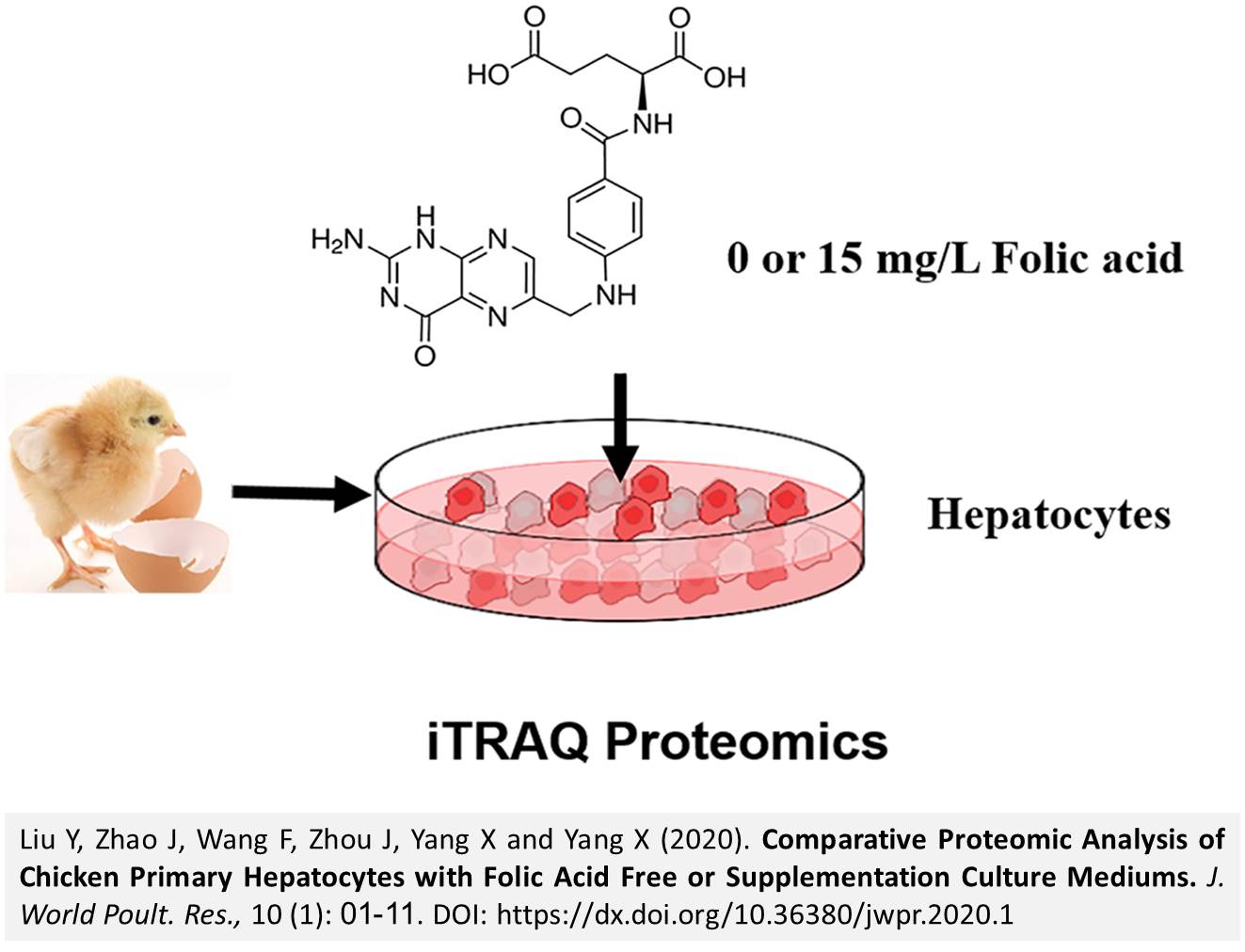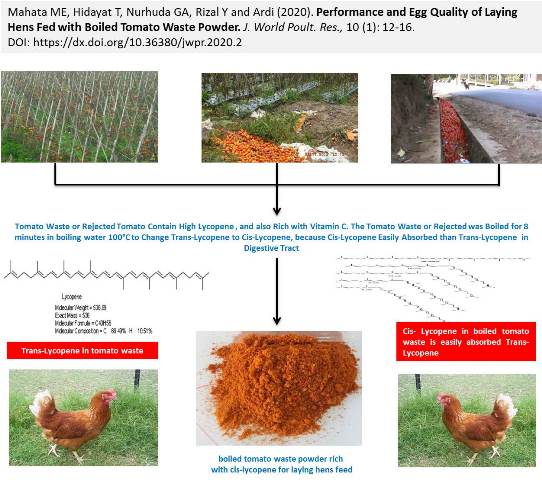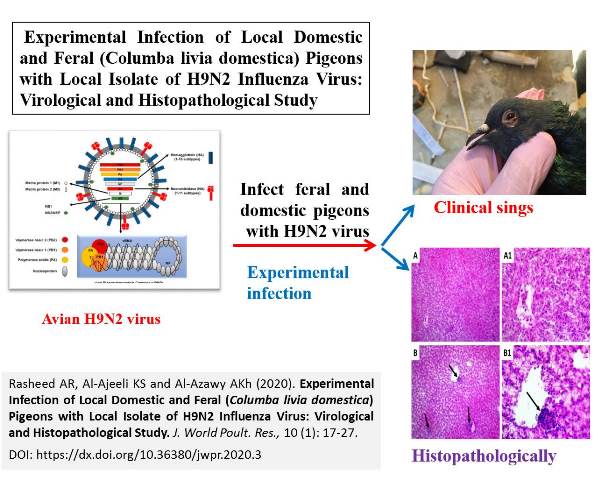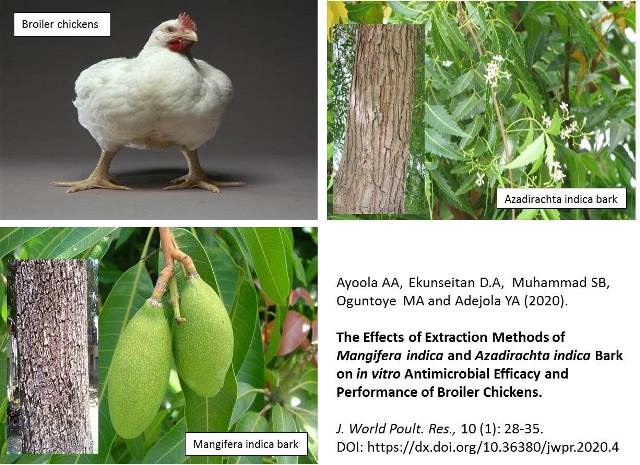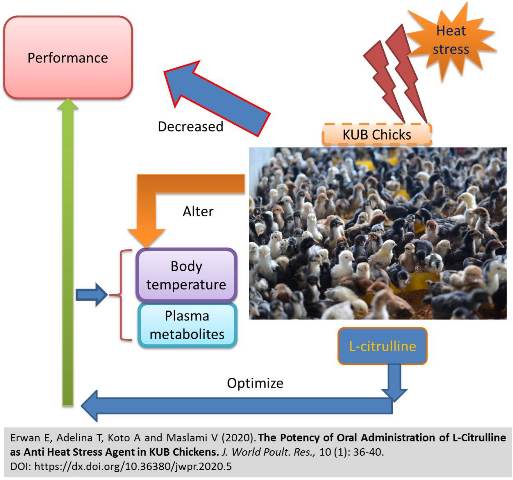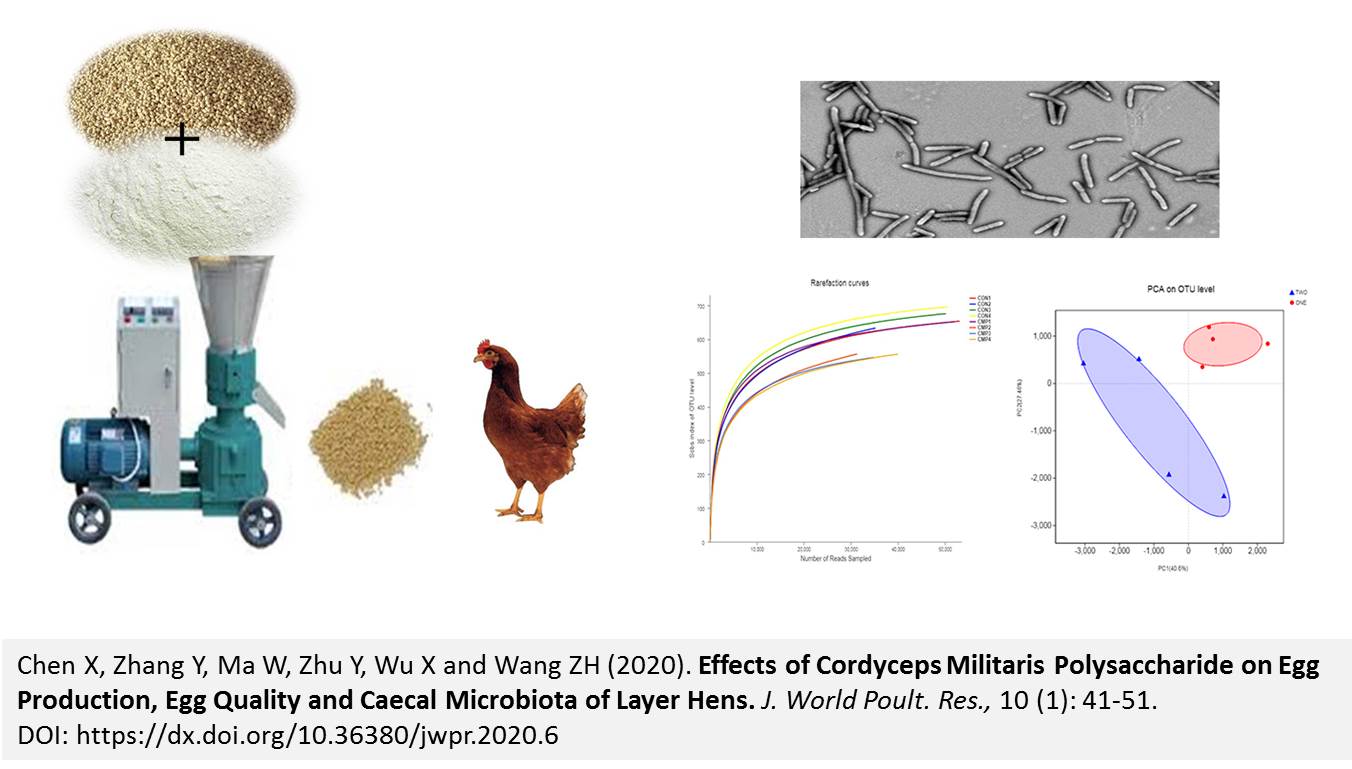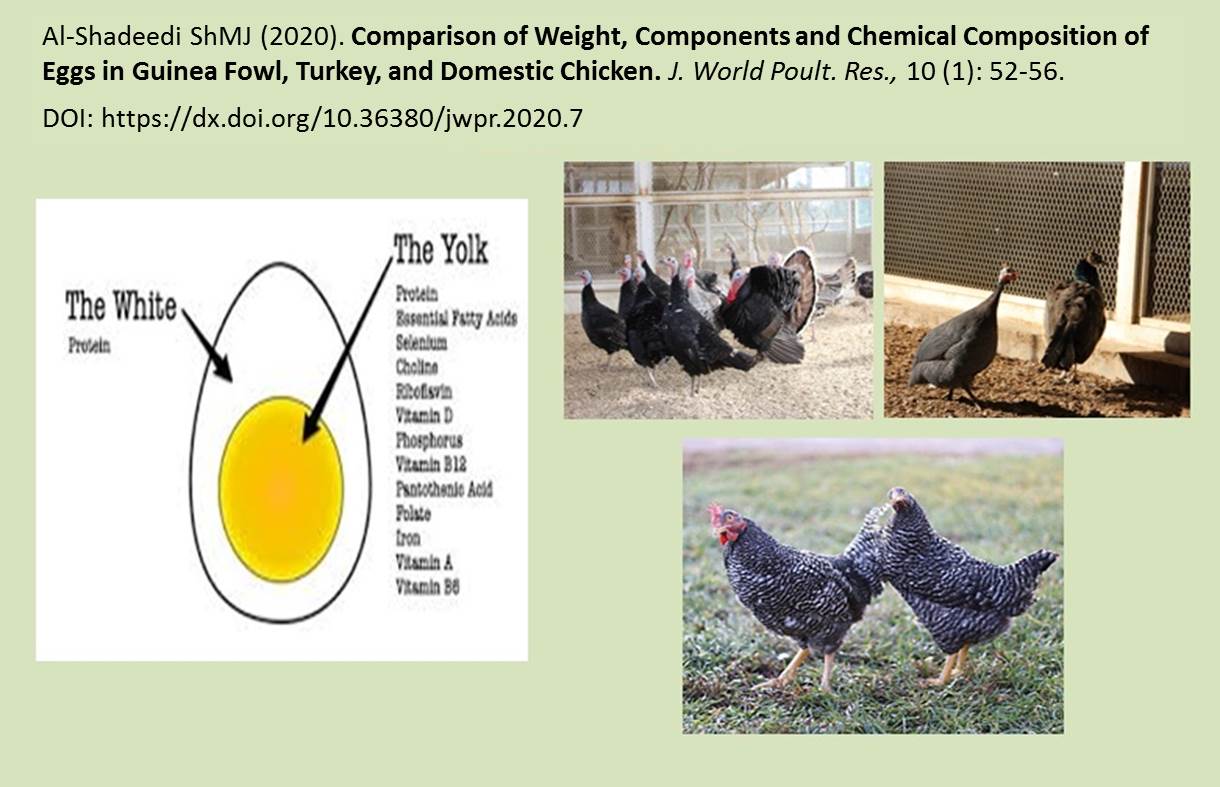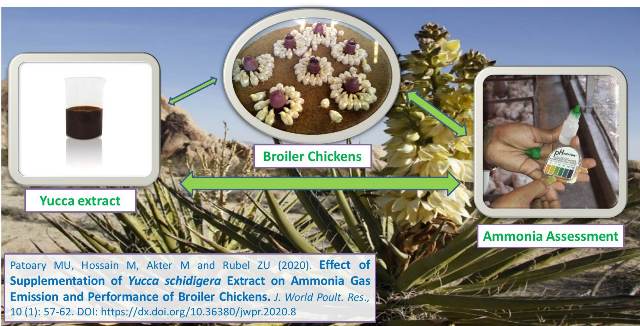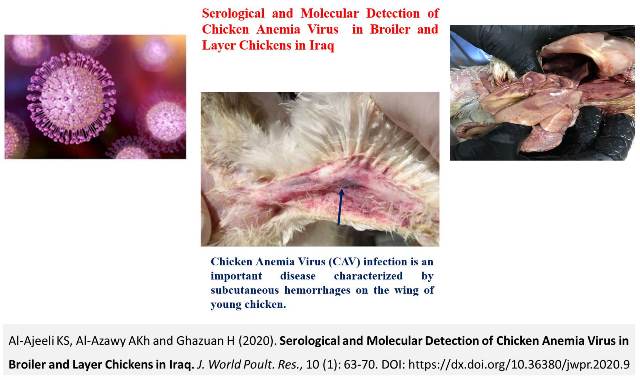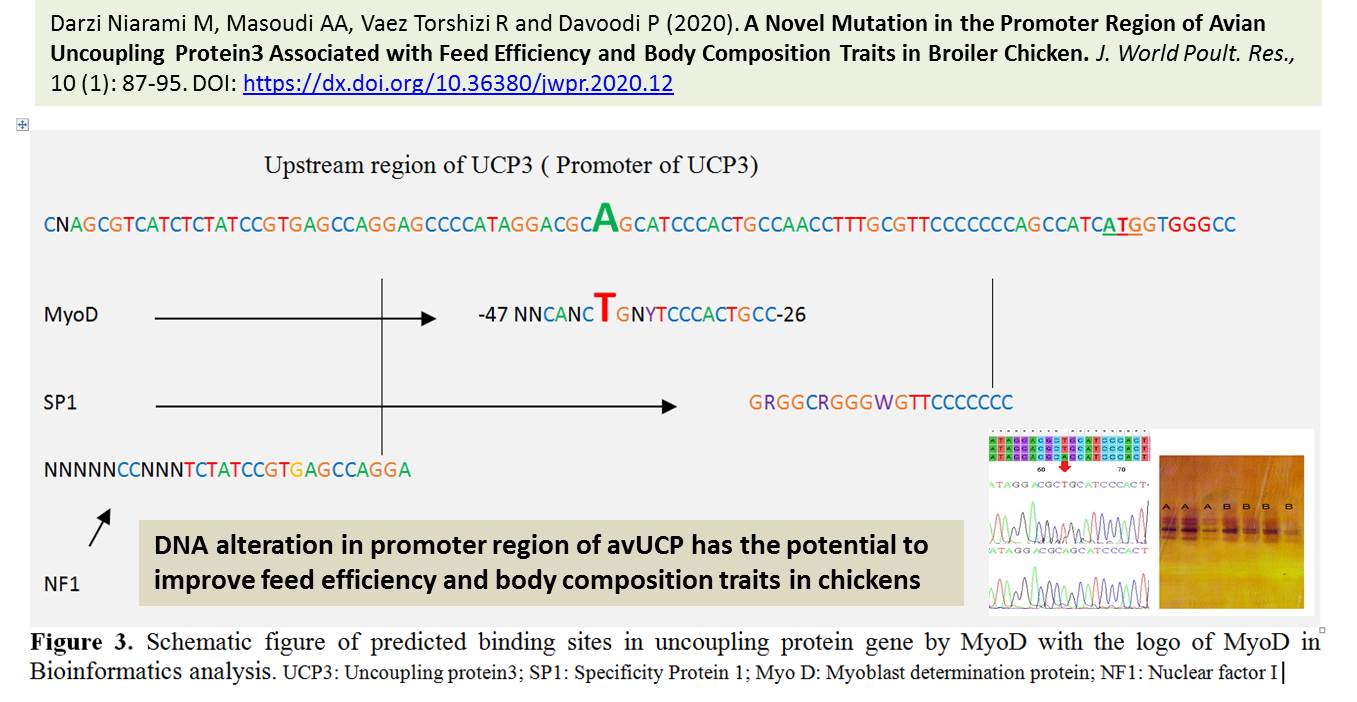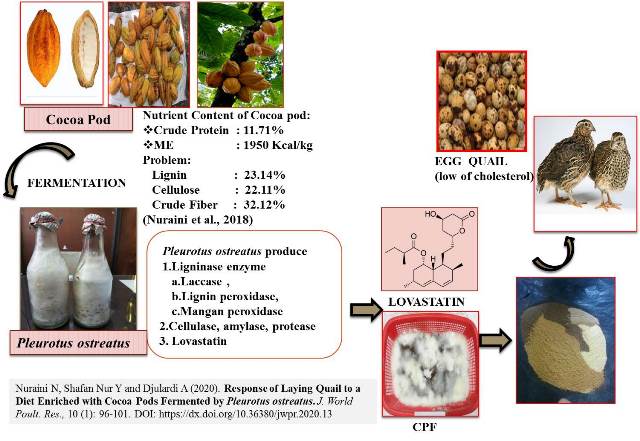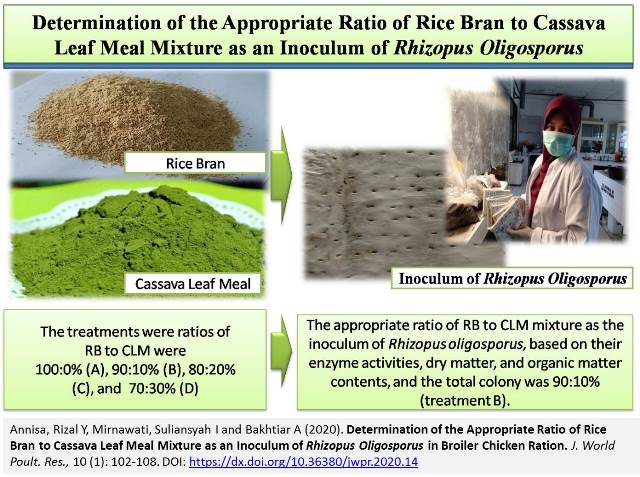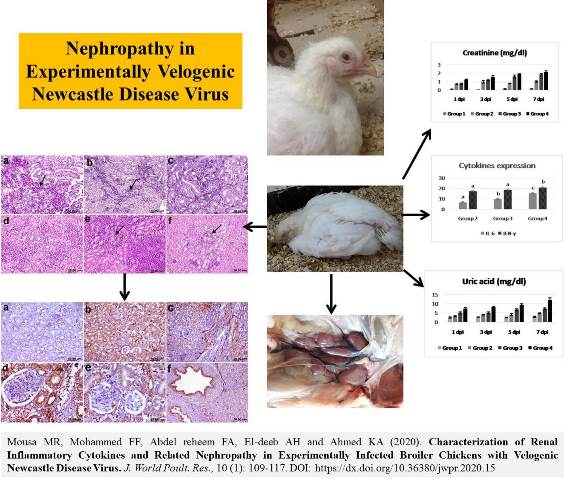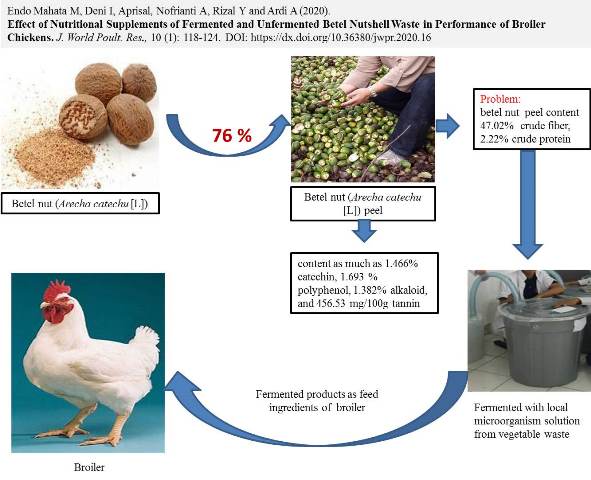Previous issue | Next issue | Archive
Volume 10 (1); March 25, 2020 [Booklet] [EndNote XML for Agris]![]()
Comparative Proteomic Analysis of Chicken Primary Hepatocytes with Folic Acid Free or Supplementation Culture Mediums.
Liu Y, Zhao J, Wang F, Zhou J, Yang X and Yang X.
J. World Poult. Res. 10(1): 01-11, 2020; pii: S2322455X2000001-10
DOI: https://dx.doi.org/10.36380/jwpr.2020.1
ABSTRACT: Folic acid had been reported to develop much metabolic regulation function in animals and human beings due to its roles in one carbon metabolism. The current study was conducted to explore folic acid regulation function in primary chicken hepatocytes via supplement and deprivation culture models based on proteomic analysis. Results have shown that folic acid supplement significantly increased intracellular folic acid, 5-Me-THF and SAM contents when compared with folic acid free group (P < 0.05). Whereas, there was no difference about genome 5mC levels and DNMTs mRNA expression between these two groups. Proteomic analysis found 85 differential expressed proteins with 35 down and 50 up regulation. COG and KEGG pathway analysis revealed that amino acid metabolism, carbohydrate metabolism and antioxidant function were affected by folic acid. Posttranslational modification, protein turnover, chaperones and transcription were gathered by COG analysis in relative high proportion. PRMT7 and ARID4B which were associated with histone methylation were up-regulated in the folic acid supplement group, suggesting that folic acid was likely to take part in metabolism regulation of hepatocytes via histone methylation manner in the study. In conclusion, proteomic analysis found 85 differential expressed proteins in hepatocytes with folic acid free and supplementation medium. Folic acid might be involved in amino acid and carbohydrate metabolism and oxidation resistance by its epigenetic modifications functions. Our study also provided fundamental differential protein profiles mediated by folic acid, which can facilitate the understanding of folic acid regulation function in hepatic metabolism.
Key words: Folic acid, Histone methylation, Primary chicken hepatocytes, Proteomics
[Full text-PDF] [XML] [Crossref Metadata] [Google Scholar]
Performance and Egg Quality of Laying Hens Fed with Boiled Tomato Waste Powder.
Mahata ME, Hidayat T, Nurhuda GA, Rizal Y and Ardi.
J. World Poult. Res. 10(1): 12-16, 2020; pii: S2322455X2000002-10
DOI: https://dx.doi.org/10.36380/jwpr.2020.2
ABSTRACT: This study was performed to evaluate the effect of inclusion of boiled tomato waste powder in laying hens diet on growth performances and egg quality. Tomato waste used in this experiment was surplus and unsold mature tomato from the last harvest on the field. The tomato waste was boiled in boiling water (100 ºC) for 8 minutes to convert their lycopene structure from trans to cis, which is easily absorbed by the poultry digestive tract. In a completely randomized design, 200 Isa Brown laying hens were divided into five groups with different inclusion levels of boiled tomato waste powder (0, 3, 6, 9 and 12%) in an iso-nitrogenous (16%) and iso-caloric (2600 kcal/kg) diet. Daily feed intake, hen day egg production, egg weight, egg mass, feed conversion ratio, eggshell thickness, and eggshell strength were measured. The obtained results showed that boiled tomato waste powder in the diet did not significantly affect daily feed intake, feed conversion ratio, egg production and egg quality. In conclusion, the tomato boiled powder could be used up to 12% in laying hens diet with no effect on performance and egg quality of laying hens.
Key words: Diet, Egg quality, Layer performance, Lycopene, Tomato
[Full text-PDF] [XML] [Crossref Metadata] [Google Scholar]
Experimental Infection of Local Domestic and Feral (Columba livia domestica) Pigeons with Local Isolate of H9N2 Influenza Virus: Virological and Histopathological Study.
Rasheed AR, Al-Ajeeli KS and Al-Azawy AKh.
J. World Poult. Res. 10(1): 17-27, 2020; pii: S2322455X2000003-10
DOI: https://dx.doi.org/10.36380/jwpr.2020.3
ABSTRACT: A local isolate of low pathogenic Avian Influenza Virus (AIV) H9N2 subtype was used in experimental infection of 50 domestic and 50 feral pigeons (Columba livia domestica) to determine the susceptibility of these birds to H9N2 infections and to study its histopathological effects on vaccinated and unvaccinated pigeons with H9N2 commercial vaccine. The birds were divided into five groups. Groups A and C contained 20 feral pigeons, B and D contained 20 domesticated pigeons. Group E contained 10 feral and 10 domesticated pigeons that were used as unvaccinated controls. Groups A and B were vaccinated with H9N2 and Newcastle disease virus commercial vaccines. Group C and D were vaccinated with Newcastle disease virus vaccine only. All groups except E were challenged with a local isolate of H9N2 serotype. Antibodies titers against AIV were estimated pre and post-vaccination using ELISA. The results indicated low antibody titers against AIV in all groups in pre-vaccination that ranged between 152.83 ± 42.01 and 337.00 ± 150.76 with no significant differences between groups. Post-vaccination antibody evaluation indicated high titers of anti-AIV antibodies in groups A and B (740.13 ± 214.38 and 673.00 ± 242.40, respectively) in comparison to pre-vaccination levels. Clinical signs appeared on 5th day post-vaccination that included mild respiratory signs, digestive disorders, and conjunctivitis in some birds of all groups. Histopathological changes in affected tissues appeared as moderate to severe multifocal necrosis diffused in the parenchymal cells of lung tissues. Infiltration with mononuclear inflammatory cells was detected in some lung tissue areas. Necrotic foci and mononuclear cell infiltration were also observed in trachea and liver of infected pigeons but mild changes were observed in intestine. The challenge virus was re-isolated in embryonated hen's eggs of nine days old by inoculation in allantoic cavity using samples collected from tissues and cloaca of infected pigeons showing clear clinical signs. The re-isolated virus was detected by the haemagglutination test using chicken RBCs and identified by haemagglutination inhibition test using a locally prepared hyperimmune serum to H9N2 in rabbits. In conclusion, pigeons are susceptible to AIV (H9N2) that might facilitate the transmission of the virus to other bird species.
Key words: Avian Influenza viruses, H9N2, Pigeons
[Full text-PDF] [XML] [Crossref Metadata] [Google Scholar]
The Effects of Extraction Methods of Mangifera indica and Azadirachta indica Bark on in vitro Antimicrobial Efficacy and Performance of Broiler Chickens.
Ayoola AA, Ekunseitan D.A, Muhammad SB, Oguntoye MA and Adejola YA.
J. World Poult. Res. 10(1): 28-35, 2020; pii: S2322455X2000004-10
DOI: https://dx.doi.org/10.36380/jwpr.2020.4
ABSTRACT: This study investigated the in vitro efficacy of extracts of Mangifera indica and Azadirachta indica bark obtained by different extraction methods. Also, in an eight-week trial, the effect of these extracts on the performance of broiler chickens were evaluated. The barks were collected, air-dried and pulverized. The samples were extracted using maceration, infusion, and decoction methods. The extracts were screened for their activity against Escherichia coli and Streptococcus aureus. Two hundred and eighty-eight birds were divided into two groups (144 each) administered with A. indica or M. indica. Each group was subdivided into four subgroups, including control subgroup (no herb) and subgroups administered with bark extracted by one of the three extraction methods. The birds on herbal treatments were not given antibiotics. Results showed that the growth of E. coli was more inhibited by the various extracts irrespective of the methods of extraction. Weights were significantly influenced by the interaction between herb types and extraction methods at the starter phase. Infused herbs induced mortality at the finisher phase. In conclusion, S. aureus was more susceptible to the extracts compared to E. coli. However, decocted A. indica and M. indica bark, as well as macerated M. indica, showed antimicrobial potency against E. coli. It can be recommended that neem or mango bark extracted by maceration or decoction can be administered orally to broiler chickens especially at the starter phase, for improved performance and reduced mortality.
Key words: Antimicrobial assay, Azadirachta indica, Extraction, Mangifera indica, performance
[Full text-PDF] [XML] [Crossref Metadata] [Google Scholar]
The Potency of Oral Administration of L-Citrulline as Anti Heat Stress Agent in KUB Chickens.
Erwan E, Adelina T, Koto A and Maslami V.
J. World Poult. Res. 10(1): 36-40, 2020; pii: S2322455X2000005-10
DOI: https://dx.doi.org/10.36380/jwpr.2020.5
ABSTRACT: L-citrulline (L-Cit) is considered one of the potential amino acids that are able to reduce body temperature in layer chicks. However, there are no reports on functions of L-Cit in KUB chicks. Therefore, the present study aimed to evaluate the effects of oral administration of L-Cit on feed intake, body temperature and plasma biochemical parameters of KUB chicks over two hours post-administration. Neonatal KUB chicks were orally administered with different doses of L-Cit (0, 3.75, 7.5 and 15 mmol/kg body weight). At 30, 60 and 120 min, feed intake was determined, also rectal temperature of chicks was measured by using a digital thermometer. At 120 min after administration, the blood samples were immediately collected through the jugular vein, then biochemical parameters of plasma (total cholesterol, triacylglycerol and total glucose) were analyzed. The obtained results indicated that feed intake, body temperature, and plasma metabolites were not significantly influenced by different doses of L-Cit. In conclusion, L-Cit could not able to improve feed intake, decrease body temperature and change plasma metabolites in KUB chicks.
Keywords: Body temperature, Feed intake, KUB chick, L- citrulline, Plasma metabolites
[Full text-PDF] [XML] [Crossref Metadata] [Google Scholar]
Effects of Cordyceps Militaris Polysaccharide on Egg Production, Egg Quality and Caecal Microbiota of Layer Hens.
Chen X, Zhang Y, Ma W, Zhu Y, Wu X and Wang ZH.
J. World Poult. Res. 10(1): 41-51, 2020; pii: S2322455X2000006-10
DOI: https://dx.doi.org/10.36380/jwpr.2020.6
ABSTRACT: The present study was conducted to determine the effects of the diet supplementation of laying hens with Cordyceps Militaris Polysaccharide (CMP) on egg production and quality, and also caecal microbiota. A total of 360 Hy-Line Brown laying hens with 72-week-old were divided into three groups with four replicates of 30 birds each. The laying hens were fed with basal diet (control group), basal diet +100 mg CMP/kg (group 1) and basal diet + 200 mg CMP/kg (group 2). The experiment lasted 45 days. Eggs were collected daily and caecal samples were collected at the end of the experiment. Results showed that dietary supplementation with CMP did not affect albumen height, shape index, Haugh units, eggshell breaking strength and eggshell thickness. The laying rate significantly increased and the feed-egg ratio decreased in groups 1 and 2, the average daily egg weight significantly increased in group 2 compared with those in the control group. However, insignificant differences were found in broken egg rate and mortality among the three groups. The differences in caecal microbiota between group one and the control group were significant. The relative abundance of Firmicutes, Bacteroidetes and Proteobacteria at the phylum level, Christensenellaceae and Veillonellaceae at the family level, and the no rank_ Ruminococcaceae, Phascolarctobacterium and no rank Christensenellaceae at the genus level changed significantly in group one compared with those in the control group. In conclusion, dietary supplementation with 100 and 200 mg CMP/kg could improve product performance and affect the caecal microbial community structure of laying hens during the late laying period.
Key words: Cordyceps militaris polysaccharide, Egg production, Egg quality, Gut microbiome, Hens
[Full text-PDF] [XML] [Crossref Metadata] [Google Scholar]
Comparison of Weight, Components and Chemical Composition of Eggs in Guinea Fowl, Turkey, and Domestic Chicken.
Al-Shadeedi ShMJ.
J. World Poult. Res. 10(1): 52-56, 2020; pii: S2322455X2000007-10
DOI: https://dx.doi.org/10.36380/jwpr.2020.7
ABSTRACT: The present study was carried out to compare the physicochemical characteristics of eggs of guinea fowl, turkeys and domestic chickens outdoor reared in traditional farms in Baghdad, Iraq. A total of 166 fresh eggs; 32 eggs from guinea fowls (Numida meleagris), 44 eggs from turkeys (Meleagris gallopavo) and 90 eggs from domestic chickens; were collected. Egg weight, percentage of egg components, chemical composition (protein, lipids, and ash), and lipid profile were determined. Results revealed the significant differences in egg weight among studied birds. The average egg weights for guinea fowl, turkey, and indigenous chicken were 83.15 ± 0.72, 92.41 ± 0.78 and 61.28 ± 0.62 g, respectively. No significant differences were found in egg components and the chemical composition of the edible portions of the eggs among studied birds. However, the lipid profile of egg yolk indicated that egg cholesterol and LDL levels were significantly higher in guinea fowl and turkey compared with those in indigenous chickens, whereas native chicken has high values of HDL compared to guinea fowl and turkey. There were no significant differences in the triglyceride level in egg yolks among the studied fowls. In conclusion, although egg weight was significantly different among studied birds, eggs of guinea fowl, turkeys, and domestic chickens were similar in nutritional components.
Key words: Chemical composition, Domestic chicken, Egg Components, Guinea fowl, Turkey.
[Full text-PDF] [XML] [Crossref Metadata] [Google Scholar]
Effect of Supplementation of Yucca schidigera Extract on Ammonia Gas Emission and Performance of Broiler Chickens.
Patoary MU, Hossain M, Akter M and Rubel ZU.
J. World Poult. Res. 10(1): 57-62, 2020; pii: S2322455X2000008-10
DOI: https://dx.doi.org/10.36380/jwpr.2020.8
ABSTRACT: The current study was conducted to investigate the efficacy of Yucca extract (YE) on ammonia gas emission from litter, evaluate the production performance, carcass characteristics and economic utility in broiler rearing. A trial of 240 day-old commercial broiler chicks was carried out on littered floor for a period of 28 days. The birds were allocated randomly to 3 treatments and a control group with three replications (20 birds/ replication). Feeding management and rearing condition were same for all the groups, as per standard. YE was mixed with drinking water as treatment as follows: 1ml YE per 16 liters of drinking water (T1), 1ml YE per 20 liters of drinking water (T2), 1ml YE per 24 liters of drinking water (T3) and no YE in drinking water i.e control group (T0). Ammonia level of Yucca treated groups were significantly (Pth week of rearing period than control group. A significant difference (P2 group was better than other groups. This study concluded that application of YE (1ml/ 20 liters of drinking water) has an important role to reduce ammonia gas emission from broiler litter and increase the birds performance.
Keywords: ammonia control, broiler chicken, litter management, Yucca schidigera
[Full text-PDF] [XML] [Crossref Metadata] [Google Scholar]
Serological and Molecular Detection of Chicken Anemia Virus in Broiler and Layer Chickens in Iraq.
Al-Ajeeli KS, Al-Azawy AKh and Ghazuan H.
J. World Poult. Res. 10(1): 63-70, 2020; pii: S2322455X2000009-10
DOI: https://dx.doi.org/10.36380/jwpr.2020.9
ABSTRACT: Chicken Anemia Virus (CAV) infects many bird species worldwide and causes immunosuppression. This condition can facilitate the infection of affected birds with other pathogens including bacteria, viruses, and fungi. No data were available on detection or isolation of CAV from birds in Iraq, therefore this study was designed to detect CAV antibodies in broilers and layers in some poultry farms. Accordingly, 200 samples were collected from broiler and layer farms (100 samples each) from different districts of Diyala province and subjected to the ELISA test. Also, 50 tissue samples from embryonated eggs from different hatcheries, four commercial viral vaccines, and 30 ELISA positive samples were subjected to PCR assay to detect the CAV DNA. The results showed that all of broiler and layer farms sampled were serologically positive for CAV antibodies. The overall seropositivity for CAV antibodies for both chicken breeds was 51.5%. In broilers, 43 out of 100 serum samples were positive for CAV antibodies, whereas 60 out of 100 serum samples from layers were CAV antibody-positive. According to age groups, significant differences were observed among one-week-old broilers (30.2%) compared to other age groups. In layers, the age group of 30 weeks showed a seropositivity rate of 33.3%. Conventional PCR test indicated that all tissue samples collected from suspected birds and embryonated eggs were negative for CAV DNA, but only 2 out of 30 serum samples were PCR positive. It is concluded that CAV is endemic in poultry farms of Iraq and may facilitate the vaccination failure against other viruses.
Key words: Broilers, Chicken anemia virus, ELISA, Layers, PCR
[Full text-PDF] [XML] [Crossref Metadata] [Google Scholar]
Molecular Characterization and Phylogenetic Analysis of Full-length S1 Gene of GI-16 and GI-23 Infectious Bronchitis Virus in Qena, Egypt.
Sabra M, Abdellatif W, Ahmed AI and Osman N.
J. World Poult. Res. 10(1): 71-80, 2020; pii: S2322455X2000010-10
DOI: https://dx.doi.org/10.36380/jwpr.2020.10
ABSTRACT: Infectious Bronchitis Virus (IBV) is a highly evolving virus that affects respiratory, urinary and reproductive systems. This virus is recognized as an important pathogen due to the continuous genesis of new variants that threaten the poultry industry worldwide. The aim of this study was to characterize emerging IBV variants originated from field outbreaks in Qena province, Egypt, and to study their genetic relationships with global strains. From September 2017 to January 2019, 52 field samples were collected from broiler flocks suspected of being infected with IBV. The collected samples were inoculated into embryonated chicken eggs via allantoic route for virus isolation. The IBV presence was confirmed using real-time reverse transcriptase PCR (rRT-PCR) assay targeting nucleocapsid (N) gene and finally, nine samples were selected from 29 positive samples with rRT-PCR for further genetic characterization through full-length spike (S1) gene sequencing. Phylogenetic analyses indicated that one isolate (IBV/CK/EG/QENA-4/2017) clustered within genotype I lineage 16 (GI-16). On the other hand, the remaining eight isolates (2017-2018) belonged to genotype I lineage 23 (GI-23) and clustered separately in monophyletic clade. The isolates in this study were found to share only 74.6-82.1% amino acid identity with the commonly used vaccine strains in Egypt. In conclusion, findings of this study provide informative data on circulating IBVs in the study area and highlight the importance of adopting a convenient vaccination strategy that can be more efficient for controlling the emergence of new IBV variants.
Key words: Full-length spike gene, GI-16, GI-23, Infectious bronchitis virus, Phylogenetic, RT-PCR.
[Full text-PDF] [XML] [Crossref Metadata] [Google Scholar]
Influence of Adding Fermented Whey Cheese into Drinking Water of Laying Hens.
Hilmi M, Prastujati UA, Khusnah A, Khirzin MH and Yannuarista D.
J. World Poult. Res. 10(1): 81-86, 2020; pii: S2322455X2000011-10
DOI: https://dx.doi.org/10.36380/jwpr.2020.11
ABSTRACT: Cheese production waste contains carbon source, one of which is lactose as an energy source in the development of fermentation, especially in the manufacture of probiotics for poultry. The research method used 3% fermented cheese whey in 17-week-old laying hen drinking water to analyze the productivity of laying hens and microbiology. The purpose of the research is to determine the effective concentration of fermented whey cheese to improve productivity, physical and chemical composition of eggs, and evaluate fat metabolism in laying hens. The present study used 120 laying hens aged 17 weeks. The experimental method was designed using the T-test method of control (P0), fermented whey cheese (P1). The observed variables were productivity (feed consumption, water consumption, daily egg production, feed conversion ration), and microbiology of small intestine and excreta (lactate acid bacteria, salmonella, Escherichia coli.). The effect of adding fermented whey cheese into drinking water decreased feed consumption and FCR in contrast to the control group (P0) but increased egg production, egg weight, and egg mass weight. The effect of adding fermented whey cheese into drinking water decreased the number of, Escherichia coli bacteria and increases lactic acid bacteria in the digestive tract of broiler chickens, especially in the ileum, caeca, so also with those in the stool. The number of Salmonella Bacteria was significantly decreased and very significantly increased lactic acid bacteria in the feces during the fermentation of whey cheese. The decrease in ammonia in the stool was very significant compared to the control group. In conclusion, adding fermented whey cheese into drinking water can reduce feed consumption, feed conversion ratio (FCR), Escherichia coli, salmonella, ammonia (NH3), and increase egg production, egg weight, egg mass weight, final body weight, and lactate acid bacteria. The use of fermented whey cheese can be used as a nutraceutical feed additive to inhibit pathogenic bacteria in the intestine and increase lactic acid bacteria.
Key words: Drinking water, Fermented, Laying hens, Whey cheese
[Full text-PDF] [XML] [Crossref Metadata] [Google Scholar]
A Novel Mutation in the Promoter Region of Avian Uncoupling Protein3 Associated with Feed Efficiency and Body Composition Traits in Broiler Chicken.
Darzi Niarami M, Masoudi AA, Vaez Torshizi R and Davoodi P.
J. World Poult. Res. 10(1): 87-95, 2020; pii: S2322455X2000012-10
DOI: https://dx.doi.org/10.36380/jwpr.2020.12
ABSTRACT: The Avian Uncoupling Protein (avUCP) belongs to the mitochondrial anion transporter family. It has a pivotal homeostatic mechanism that associated with energy regulation and lipid metabolism. The avUCP considered as a candidate gene for chicken growth-related traits according to its predominant expression is in skeletal muscle. To address genetic distance pattern of UCP3 between mammalian and avian species, sequence similarity analysis using the protein alignment of UCP3 identified the high amino acid identity between the species and complementarily detected two protein conserved regions which are known as the ADP/ATP transporter translocase and the Mitochondria-carrier. Likewise, for mutation detection, samples were genotyped, afterward PCR-SSCP method implemented. In addition, association analysis was performed for investigating single nucleotide polymorphism within the UCP3 gene relating to the given economic traits. A detected polymorphic site, on the promoter region of UCP3 (-40 T/A substitution), has displayed significant influences on the Feed Conversion Rate (FCR), Residual Feed Intake (RFI), Average Daily Gain (ADG), and Carcass Weight (CW%). In the case that, birds with genotype AA had better FCR, ADG, RFI as compared to the genotype BB and birds with genotype AA revealed a higher CW% as compared to the genotype BB. According to the obtained results from the in-silico survey, Myoblast determination protein (MyoD) was predicted as a best-matched transcription factor with a consensus sequence harboring the -40 T/A -novel SNP- in the promoter region of UCP3, where might be responsible for phenotypic variation between two genotypes. In conclusion, the result suggests important roles for UCP3 polymorphism in feed efficiency and growth traits which is better to be used in broiler chicken breeding programs.
Key words: Association analysis, Avian uncoupling protein3, Body composition traits, Broiler chicken, Feed efficiency, Novel mutation
[Full text-PDF] [XML] [Crossref Metadata] [Google Scholar]
Response of Laying Quail to a Diet Enriched with Cocoa Pods Fermented by Pleurotus ostreatus.
Nuraini N, Shafan Nur Y and Djulardi A
J. World Poult. Res. 10(1): 96-101, 2020; pii: S2322455X2000013-10
DOI: https://dx.doi.org/10.36380/jwpr.2020.13
ABSTRACT: Improving the quality of cocoa pods through fermentation with Pleurotus ostreatus reduced its crude fiber content, especially for lignin and cellulose. Fermentation of cocoa pods product increased their utilization in poultry diet. An experiment was conducted to determine the effect of feeding cocoa pods waste fermented by Pleurotus ostreatus on the laying performance and egg quality of quail. This experiment employed completely randomized design with five dietary treatments: 0%, 5%, 10%, 15% and 20% cocoa pods fermented by Pleurotus ostreatus in the diets and four replications. 200 laying quail (7 weeks of age) were randomly allocated into 5 treatments (10 birds per treatment) and 4 replications. Diets included iso nitrogen 20% and iso metabolism energy 2800 kcal/kg. The results of the experiment indicated that feed intake, hen-day egg production, egg weight, egg mass production, and feed conversion were not affected but egg cholesterol was affected by increasing cocoa pods fermented products in the diet. In this experiment, a diet which utilized 15% cocoa pods fermented using Pleurotus ostreatus maintained the laying performance of quail and reduced egg yolk cholesterol (20.30%).
Key words: Cocoa pods, Egg quality, laying Quail, Performance, Pleurotus ostreatus
[Full text-PDF] [XML] [Crossref Metadata] [Google Scholar]
Determination of the Appropriate Ratio of Rice Bran to Cassava Leaf Meal Mixture as an Inoculum of Rhizopus Oligosporus in Broiler Chicken Ration.
Annisa, Rizal Y, Mirnawati, Suliansyah I and Bakhtiar A.
J. World Poult. Res. 10(1): 102-108, 2020; pii: S2322455X2000014-10
DOI: https://dx.doi.org/10.36380/jwpr.2020.14
ABSTRACT: Rice bran (RB) was used as a medium for the fermentation process because it contained complete nutrients necessary for the growth of microbes. The ability to induce a fermentation substrate by microbes dependent on the availability of an inducer in the medium. The enzyme activity would increase when a suitable inducer was in the medium. In order to increase protease and cellulase activities of Rhizopus oligosporus in processing Cassava Leaf Meal (CLM), it was necessary to add CLM in medium producing an inoculum Rhizopus oligosporus. This study was conducted in a completely randomized design with 4 treatments and 5 replications. The treatments were ratios of RB to CLM as follows: 100:0% (A), 90:10% (B), 80:20% (C), and 70:30% (D). The observed variables were protease activity, cellulase activity, dry matter content, organic matter content and the total colony of Rhizopus oligosporus numerically. The different ratios of RB to CLM significantly affected protease and cellulase activities as well as the content of dry matter and organic matter. The addition of 10% CLM to the RB medium increased protease and cellulase activities and reduced dry matter and organic matter contents. However, when more than 10% CLM was added, it reduced the protease and cellulase activities and increased dry matter and organic matter content. The highest total colony of Rhizopus oligosporus was numerically in treatment B (90:10% of RB to CLM ratio). The appropriate ratio of RB to CLM mixture as the inoculum of Rhizopus oligosporus, based on their enzyme activities, dry matter, and organic matter contents, and the total colony was 90:10% (treatment B).
Key words: Cassava leaf meal, Enzyme activity, Inoculum, Rhizopus oligosporus, Rice bran.
[Full text-PDF] [XML] [Crossref Metadata] [Google Scholar]
Characterization of Renal Inflammatory Cytokines and Related Nephropathy in Experimentally Infected Broiler Chickens with Velogenic Newcastle Disease Virus.
Mousa MR, Mohammed FF, Abdel reheem FA, El-deeb AH and Ahmed KA
J. World Poult. Res. 10(1): 109-117, 2020; pii: S2322455X2000015-10
DOI: https://dx.doi.org/10.36380/jwpr.2020.15
ABSTRACT: Velogenic Newcastle disease virus (VNDV) shows systemic dissemination and it affects the histological structure and function of the kidneys. Present study is an novel attempt to correlate the changes in renal biochemical functions and gene expression of different inflammatory cytokines with related renal pathology induced by VNDV in experimentally infected broilers in different ages. One hundred broiler chickens were divided into 4 groups: group 1 served as control (non-infected group), and groups 2, 3 and 4 were inoculated with 106 EID50 of NDV on the 10th, 20th and 30th days of age, respectively. Serum samples were collected to evaluate uric acid and creatinine levels. Kidney specimens were collected for virus detection using real time RT-PCR, evaluation of gene expression of IL-6 and IFN-γ as well as histopathological, histochemical and immunohictochemical analysis. The highest concentration of uric acid and creatinine profile were found in Group 4 (12.06 ± 1.25 and 2.16 ± 0.12, respectively) on 7 dpi. IL-6 and IFN-γ were significantly elevated at the 7th dpi in Group 4 compared to other infected groups. The renal histopathological lesions included tubulointerstitial nephritis and glomerulopathy with expression of virus antigen in different areas of renal tissue. histopathology was the hallmark of VNDV infection in broiler chickens; their severity was related to the increased expression of inflammatory cytokines genes (IL-6 and IFN-γ) and virus antigen residence in renal tissue.
Key words: IL-6, IFN-γ, Immunohistochemistry, Nephropathy, Velogenic NDV
[Full text-PDF] [XML] [Crossref Metadata] [Google Scholar]
Effect of Nutritional Supplements of Fermented and Unfermented Betel Nutshell Waste in Performance of Broiler Chickens.
Endo Mahata M, Deni I, Aprisal, Nofrianti A, Rizal Y and Ardi A.
J. World Poult. Res. 10(1): 118-124, 2020; pii: S2322455X2000016-10
DOI: https://dx.doi.org/10.36380/jwpr.2020.16
ABSTRACT: An experiment was conducted to see the broiler’s performance fed with fermented and unfermented betel nutshell. Harvesting betel nut seed leaved peel as a waste that contains some nutrients and active ingredients. This waste was useful for poultry feed, to maintain poultry performance and to reduce cholesterol. The aim of this research was to fermented betel nutshell waste with indigenous microorganism from a vegetable waste mixture that produced cellulase to reduce their crude fiber before feeding to the broiler. The nutrient profile and metabolizable energy of fermented betel nutshell in dry matter basis showed 15.96 % water, 84.04 % dry matter, 23.69 % crude fiber, 10.39 % crude protein, 0.31 % crude fat, 2.60% calcium, 1.26 % phosphorus, and 1360,44 kcal/kg. In this experiment betel nutshell waste from a local farmer in Indonesia, and 80 birds from the broiler strain CP 707 from Charoen Pockphand were used. The experiment was conducted in a completely randomized design with different levels of fermented betel nutshell waste (0, 2, 4, and 6%) and 6 % of unfermented of betel nutshell waste in the broiler ration. Each treatment was repeated four times. The measured values included daily feed intake, daily weight gain, feed conversion, body weight, carcass content, abdominal fat pads, lipoprotein profile (total cholesterol, low-density lipoprotein (LDL), and high-density lipoprotein (HDL) in serum of broiler chikens. The results indicated that fermented betel nutshell waste significantly increased daily feed intake, daily body weight gain, carcass content, and decreased abdominal fat pad, total cholesterol, HDL, and LDL of broiler chickens, however did not affect the feed conversion. The fermentation of betel nutshell waste with indigenous microorganism from vegetable waste mixture could be used up to 6 % in the broiler ration and had a positive effect on performance, blood serum lipoprotein, and carcass quality of broiler chickens.
Key words: Betel nutshell waste, Broiler, Crude fiber, Fermented betel nutshell waste, Performance
[Full text-PDF] [XML] [Crossref Metadata] [Google Scholar]
Previous issue | Next issue | Archive
![]() This work is licensed under a Creative Commons Attribution 4.0 International License (CC BY 4.0).
This work is licensed under a Creative Commons Attribution 4.0 International License (CC BY 4.0).

